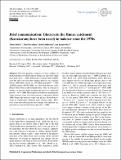Files in this item
Brief communication : Glaciers in the Hunza catchment (Karakoram) have been nearly in balance since the 1970s
Item metadata
| dc.contributor.author | Bolch, Tobias | |
| dc.contributor.author | Pieczonka, Tino | |
| dc.contributor.author | Mukherjee, Kriti | |
| dc.contributor.author | Shea, Joseph | |
| dc.date.accessioned | 2019-03-13T13:30:06Z | |
| dc.date.available | 2019-03-13T13:30:06Z | |
| dc.date.issued | 2017-02-15 | |
| dc.identifier | 258135613 | |
| dc.identifier | c88e0487-bc90-4e40-8e10-8790dde8ddbd | |
| dc.identifier | 85013013347 | |
| dc.identifier.citation | Bolch , T , Pieczonka , T , Mukherjee , K & Shea , J 2017 , ' Brief communication : Glaciers in the Hunza catchment (Karakoram) have been nearly in balance since the 1970s ' , The Cryosphere , vol. 11 , no. 1 , pp. 531-539 . https://doi.org/10.5194/tc-11-531-2017 | en |
| dc.identifier.issn | 1994-0416 | |
| dc.identifier.other | ORCID: /0000-0002-8201-5059/work/55379187 | |
| dc.identifier.uri | https://hdl.handle.net/10023/17269 | |
| dc.description.abstract | Previous geodetic estimates of mass changes in the Karakoram revealed balanced budgets or a possible slight mass gain since ∼2000. Indications of longer-term stability exist but only very few mass budget analyses are available before 2000. Here, based on 1973 Hexagon KH-9, ∼2009 ASTER and the SRTM DTM, we show that glaciers in the Hunza River basin (central Karakoram) were on average in balance or showed slight insignificant mass loss within the period ∼1973-2009. Heterogeneous behaviour and frequent surge activities were also characteristic of the period before 2000. Surge-type and non-surge-type glaciers showed on average no significantly different mass change values. However, some individual glacier mass change rates differed significantly for the periods before and after ∼2000. | |
| dc.format.extent | 9 | |
| dc.format.extent | 3554966 | |
| dc.language.iso | eng | |
| dc.relation.ispartof | The Cryosphere | en |
| dc.subject | GE Environmental Sciences | en |
| dc.subject | Water Science and Technology | en |
| dc.subject | Earth-Surface Processes | en |
| dc.subject | 3rd-DAS | en |
| dc.subject.lcc | GE | en |
| dc.title | Brief communication : Glaciers in the Hunza catchment (Karakoram) have been nearly in balance since the 1970s | en |
| dc.type | Journal article | en |
| dc.contributor.institution | University of St Andrews. School of Geography & Sustainable Development | en |
| dc.contributor.institution | University of St Andrews. Bell-Edwards Geographic Data Institute | en |
| dc.identifier.doi | 10.5194/tc-11-531-2017 | |
| dc.description.status | Peer reviewed | en |
This item appears in the following Collection(s)
Items in the St Andrews Research Repository are protected by copyright, with all rights reserved, unless otherwise indicated.

